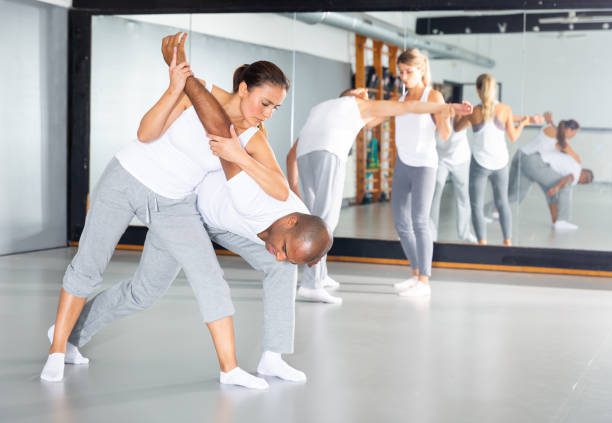You should have a clear idea about hapkido strategies before actually going to practice them. It’s always great to have a birds-eye view of all techniques of certain martial arts. In this article, you are going to get crucial and insightful information. All about hapkido 10 basic techniques, and hapkido principles.
Table of Contents
ToggleWhat is Hapkido?
The word consists of a three-syllable, hap-ki-do which means “The way of Coordinating Energy“. The main focus of hapkido techniques is dynamic kicks, joint locks, grappling, and throws. Also, this type of martial arts is a combination of different arts.
Choi Yong-Sool, a Korean master, was the person who designed the hapkido martial arts. Here’s another thing we want you to know. There are a lot of variations in hapkido art. Such as Jin Jung Kwan, Sin Moo Hapkido, and Shinshei hapkido.
The hapkido art was developed in the 20th Century as a self-defense method. It originated in Korea and became popular all over the world. Hapkido made a name because of its effectiveness and practical moves.
Talking about the hapkido moves and style. It includes all ranges of moves, short and distance moves. Besides, you’ll see a lot of weapons such as rope, sword, short stick, and nunchaku. You’ll get to learn offensive as well as defensive techniques.
Hapkido Principles:
The hapkido training system did evolve over the years. But it has a foundation of three basic principles. The following section is all about explaining those principles.
The Water Principle-Yoo:
This principle allows students to adopt all water properties such as adaptability, and softness. This principle is all about learning how water makes its way and flows through any obstruction. Also, this principle teaches harmony, tolerance, and tenderness to the practitioner.
Furthermore, students get to learn that you should use the same energy as your opponent and apply it against him. Just like the way water can even pass through the smallest nozzle or hole.
The Circle Principle-Won:
This principle involves all hapkido techniques and moves. That means each technique has to take a path and then land on the attacker. Additionally, there’s less chance of the defender’s injury but strong chances of the destruction of the attacker.
The Unity and Harmony Principle-Hwa:
The unity and harmony principle is one of the important principles of Hapkido training. The first thing in the Hwa principle is connecting the mind with the body. A way that each technique becomes the instinct of the practitioner.
The second step of this principle is harmonizing the energy of the attacker and adapting to the same level as the attacker. The learner has to make a defending move as a first response so that defending moves look natural.
RELATED: You can buy Hapkido Uniform that is comfortable and you can train easily.
Hapkido 10 Basic Techniques:
The whole idea of hapkido lessons is self-defense techniques. As we mentioned earlier, hapkido art is a blend of different martial arts techniques. That’s why it has borrowed various moves from different defensive techniques. Hapkido techniques are not just normal moves. But the learner has to use the whole body and mind as well. The use of pressure points is also a crucial part of hapkido training lists.
Phases of Techniques:
Each student will be learning the following three phases of every technique.
- Attacking
- Transition
- Conclusion
In attacking or blending, the defender has to match the energy and take the position for attack. Transition is the phase of applying a certain technique and connecting the mind with the body. The conclusion is the last phase of hapkido techniques. It includes locking, pinning, or throwing techniques are involved.

1: Hand Strikes
Hand strike is the most common technique of hapkido. This technique is the first step before going to advance hapkido moves. The defender has to use maximum force to land a strong and blunt hand strike with accuracy. It is one of the best techniques for counter-attacking purposes.
2: Kicks
Different kicks are another basic hapkido techniques that include plenty of kicking styles. Here are some examples. Roundhouse kick, front kick, backside kick, ankle scoop sidekick, and crescent kicks. The most popular kick in hapkido training is the low spinning heel kick.
3: Pinning
Pinning is an effective technique that can end the fight against an attacker. As the name implies, this technique can pin or clasp the attacker and allow you to get rid of him. Some popular pinning techniques are mentioned here. Wrist pin, wrist twist, arms pin, and wrist in turn.
4: Throwing
This technique is all about making the opponent imbalanced and using his energy and force. Throwing can also end the fight in no minutes if done properly. Some throwing techniques are followed. Such as forward and around throw, rotatory throw, wrist out turn, and entering throw as well.
5: Joint Manipulation Techniques
How can we not mention joint manipulation in our list of hapkido 10 basic techniques? This category of techniques is great for opponents’ submission without fighting much. There is a complete set of such techniques that includes wrist locks, elbow locks, and a lot of small and large joint locks.
6: Use of Weapons
There will be weapons usage in hapkido training. Also, this technique will allow a practitioner to fight against an armed person. Weapons like a sword, rope, short stick, knife, and nunchaku are used in this style of martial art. Students get to learn hapkido rope techniques in advanced training.
For dangerous situations, a defender can use the deadliest rope moves such as strangle, choke, and immobilization.
7: Pressure Point Techniques
The human body has some weak points that can be used to unconscious or immobilize someone. All kinds of martial arts follow this technique to submissive the opponent with little movement. Students learn about pressure points in separate detailed classes.
8: Wrist Locks
You can certainly find many wrist locking techniques in Hapkido. While the most famous techniques are wrist locks, pronating, supinating, and using wrist pressure points for locking. All the above-mentioned hapkido wrist techniques won’t let the opponent harm you in any way.
9: Elbow Locks
Elbow lock is a very effective kind of technique especially knife-hand elbow press. These are the first techniques taught in most hapkido schools.
10: Hammer Fist
Hammer fist strike is one of the effective self-defense hapkido techniques. Not only in hapkido but also in various kinds of martial arts. In this technique, the bottom of the fist is used with full force. After that lands the strike in a swinging motion like a hammer. You don’t have to be in a certain direction to throw it well.

Conclusion:
Hapkido is a scientific martial art with a complete and wide set of defensive and offensive techniques. Learning hapkido techniques will help you train your mind and body for any kind of dangerous situation.
Learning the hapkido self-defense system will allow you to express and feel yourself better than ever. Furthermore, the decision of hapkido learning will be the decision you make for yourself, so go for it right now.
We hope our article on hapkido 10 basic techniques helped you gain useful knowledge.
